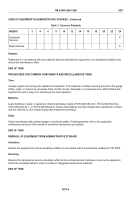TM-5-3805-264-13-P - Page 454 of 660
LINES AND PORTS
To keep dirt from contaminating fluid systems when removing and installing lines, perform the following steps:
•
Clean fittings and surrounding area before disconnecting lines.
•
Cover, cap, plug, or tape lines and ports after disconnecting lines. Use cap and plug set on hydraulic
lines.
When these are not available, use hand-carved wooden plugs, clean rags, duct tape, or other similar
materials to prevent dirt from entering system.
•
Ensure that new and used parts are clean before installing.
•
Wait to remove cover, cap, plug, or tape from lines and ports until just before installing lines.
END OF TASK
ANTISEIZING TAPE
CAUTION
•
DO NOT use antiseizing tape on air lines. Damage to air valves may result if
antiseizing tape is used.
•
Apply antiseizing tape only to pipe threads of male fittings of hydraulic system.
•
DO NOT exceed specified torque or use power tools to tighten fittings taped with
antiseizing tape. Overtightening could damage fitting threads and cause
connection to leak.
•
Failure to comply may result in damage to equipment.
When connecting hydraulic lines and fittings without compression sleeves or O-rings, antiseizing tape may be
used to keep connections from leaking. Use as follows:
•
Ensure that threads are clean and dry.
•
Start antiseizing tape one or two threads from small or leading edge of fitting, joining tape together with
an overlap of about 1/8 in. (3.18 mm) for fittings with fine threads. For fittings with coarse threads, tape
should be wrapped around threads two or three times.
•
Tightly wrap antiseizing tape in the same direction as you would tighten a nut. Tape must be pressed into
threads without cutting or ripping.
•
Using hand tools, tighten fittings to specified torque.
TM 5-3805-264-13&P
0072
0072-8
Back to Top




















